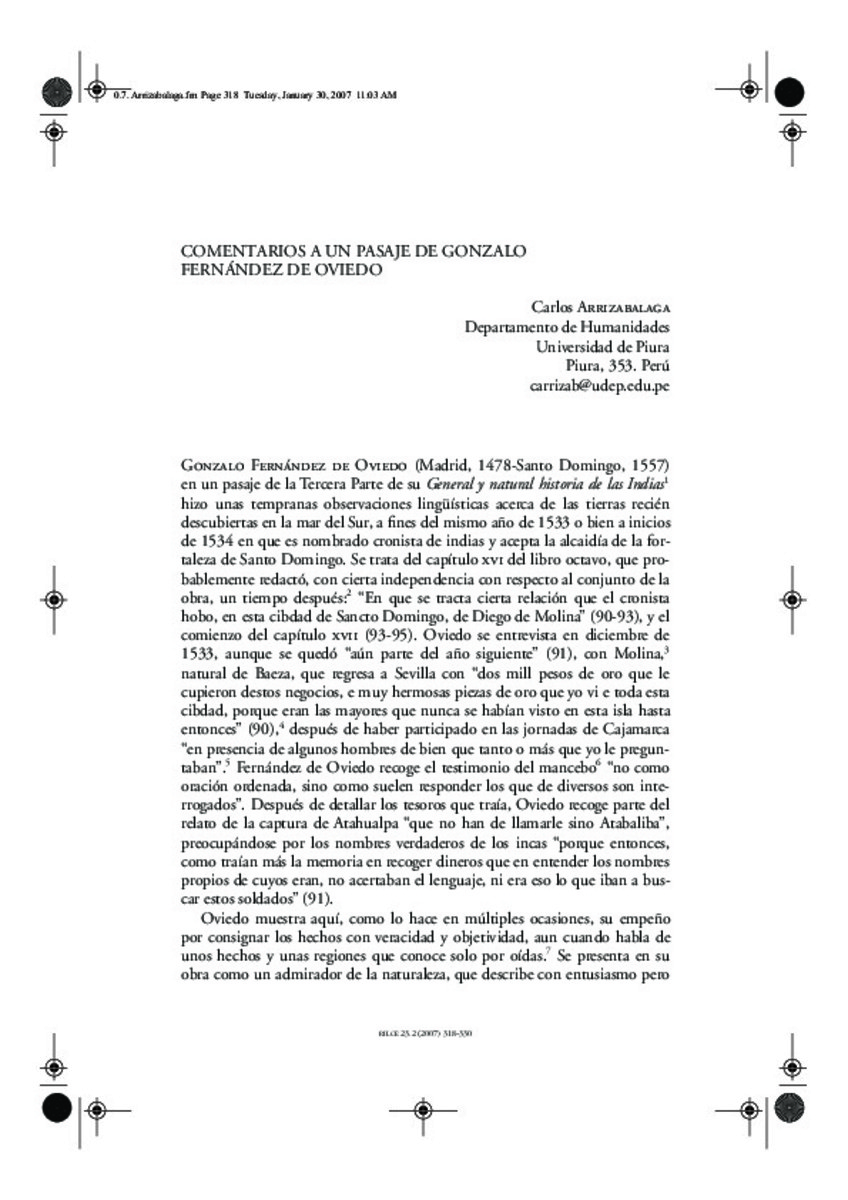Full metadata record
| DC Field | Value | Language |
|---|---|---|
| dc.creator | Arrizabalaga, C. (Carlos) | |
| dc.date.accessioned | 2010-04-13T12:26:47Z | - |
| dc.date.available | 2010-04-13T12:26:47Z | - |
| dc.date.issued | 2007 | - |
| dc.identifier.citation | Rilce 23.2 (2007): 318-330 | es_ES |
| dc.identifier.issn | 0213-2370 | - |
| dc.identifier.uri | https://hdl.handle.net/10171/6895 | - |
| dc.description.abstract | El artículo explora la presencia de algunos indoamericanismos en un pasaje de la Historia natural y general de las Indias de Gonzalo Fernández de Oviedo, en la que el cronista recoge unas noticias tempranas que le proporcionan el conquistador Diego de Molina, a su regreso a España en 1533-1534, y el piloto Pedro Corzo acerca de las tierras recién descubiertas en lo que luego será el virreinato del Perú. Junto a numerosos términos castellanos que intentan describir la realidad americana, aparecen muchos indoamericanismos de primera hora (“yuca”, “maíz”, etc.) y lo que cabe poner de relieve: algunos quechuismos (“llama”, “urco”, “uña”, “muñoma”), un término mochica o tallán (“col”) y dos términos de origen incierto (“hicomas” y “chicorras”) para los que se asigna un étimo azteca (“xicamatl”), aunque no se descartan otras interpretaciones. Todo ello refleja los momentos iniciales de la acomodación del castellano a estas tierras y la inseguridad con la que se dieron los primeros contactos lingüísticos entre españoles e indios. This article explores the presence of some indo American terms in a passage of the Historia natural y general de las Indias by Gonzalo Fernández de Oviedo, in which the columnist picks up some early news provdided by the conquer Diego de Molina, in his return to Spain in 1533-34 and the pilot Pedro Corzo about the recently discovered lands that will later become the viceroyalty of Peru. Along with numerous Castilian terms that try to describe the American reality, the first indo american terms appeared, (“yuca”, “maíz”, etc.) andi t is necessary to emphasize some quechua terms (“llama”, “urco”, “uña”, “muñoma”), a mochica or tallán term (“col”) and two terms of uncertain origin (“hicomas” and “chicorras”) for which a an Aztec etynmon is assigned (“xicamatl”), although other interpretations are not discarded. All of these reflects the inicial moments of the Castilian accomodation yo these lands and the insecurity with which the first linguistic contacts happened between Spaniards and Indians. | es_ES |
| dc.language.iso | spa | es_ES |
| dc.publisher | Servicio de Publicaciones de la Universidad de Navarra | es_ES |
| dc.rights | info:eu-repo/semantics/openAccess | es_ES |
| dc.subject | Indoamericanismos | es_ES |
| dc.subject | Fernández de Oviedo | es_ES |
| dc.subject | Perú | es_ES |
| dc.subject | siglo XVI | es_ES |
| dc.subject | Contacto de lenguas | es_ES |
| dc.subject | Indoamericanisms | es_ES |
| dc.subject | XVI Century | es_ES |
| dc.subject | Contact languages | es_ES |
| dc.title | Comentarios a un pasaje de Gonzalo Fernández de Oviedo | es_ES |
| dc.type | info:eu-repo/semantics/article | es_ES |
| dc.identifier.doi | 10.15581/008.23.26363 | es_ES |
Files in This Item:
Statistics and impact
Items in Dadun are protected by copyright, with all rights reserved, unless otherwise indicated.






